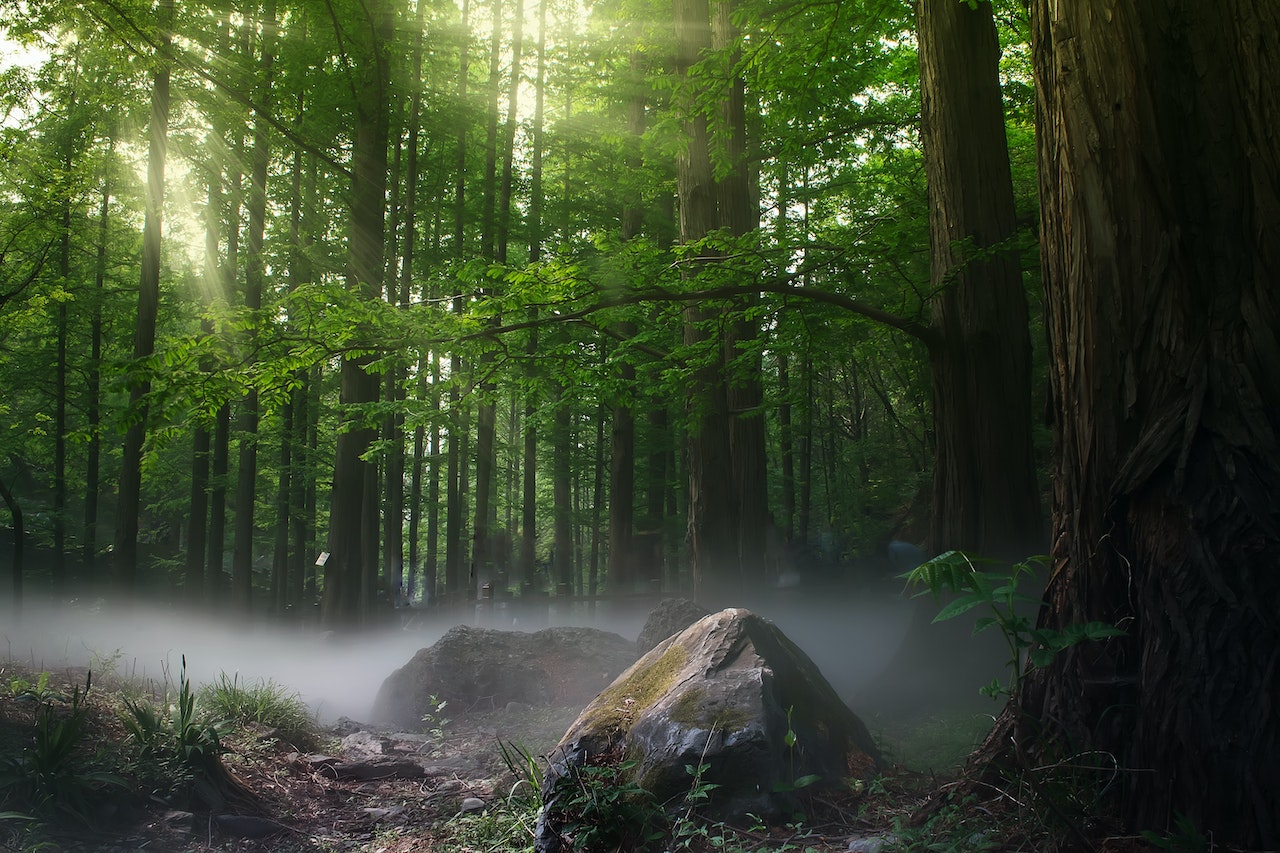This post was originally published on Healthy Forest
 Sydney Gleason served as an environmental journalism intern for Healthy Forests, Healthy Communities for the summer of 2024. Part 1 and Part 2 of her series on amending the Northwest Forest Plan was published in the Capital Press. HFHC’s environmental journalism internship encourages young journalists to learn how forest policy impacts our environment and communities.
Sydney Gleason served as an environmental journalism intern for Healthy Forests, Healthy Communities for the summer of 2024. Part 1 and Part 2 of her series on amending the Northwest Forest Plan was published in the Capital Press. HFHC’s environmental journalism internship encourages young journalists to learn how forest policy impacts our environment and communities.
Commissioner Tom Lannen guides his sedan down a quiet backroad of Skamania County, Washington and stops in front of a row of rusted mailboxes. The skeletons of tall wooden racks loom to his right. To his left, a chicken wire fence traverses an overgrown grass field. Sixty years ago, the mailboxes were shiny and stuffed to the brim. The barracks were a cone drying shed in Wind River Nursery, one of the largest tree nurseries in the United States. The field nurtured rows of trees. The road bustled with trucks transporting seedlings.
Back then Skamania County was a hub for timber production and one of the wealthiest counties in Washington. Today, restrictive federal policies are continuing to squeeze Skamania’s way of life. Trapped between the Northwest Forest Plan and the Columbia River Gorge Scenic Area, the county struggles to provide basic services while communities lack affordable housing.
Seated along the Columbia River with sweeping views of the Gorge, Skamania County houses 12,500 residents and 1.1 million acres of land. But less than two percent of that land is taxed at full market value. 762,000 acres belong to the Gifford Pinchot National Forest, and 87,000 acres lay within the Columbia River Gorge Scenic Area. This abundance of non-taxable federal land limits the county’s ability to diversify its economy and grow revenues to sustain services. Skamania’s 2023 operating budget is the same as it was 14 years ago, despite the state’s budget having increased 300 percent over the same period of time.
The 1986 Scenic Act, which protects the land along the Columbia River, was the first blow to Skamania’s prosperity. The policy restricted urban development in the Scenic Area to just 8,000 unforested acres in the towns of Stevenson, Carson, North Bonneville, and Home Valley. Most of this land has already been developed, so the county now lacks commercial land to build on. “Not only are we denied the initial bare land, but those parcels will never be sold to be developed, and we’ve reduced the number of potential housing sites,” Lannen said.
The housing shorting has skyrocketed prices. A basic 1,500 square foot home in Skamania now costs $450,000. When Ingrid Colvard, Superintendent of Schools in Stevenson-Carson, moved to the county in 2020, there were only three properties on the market. “My house is astronomically expensive for what it is. It’s ridiculous,” Colvard said.
Ten years ago, former sheriff Dave Brown had to start allowing his deputies to move outside of Skamania because they could not afford to live in county limits. Brown believes that decision has impacted local perception of the police. “When you start taking your police force out of the county, they’re no longer a part of that community,” Brown said. “Now the only people the deputies know are the ones they’re arresting every week, not the grocery store owners or the school teachers.”
Housing costs are also discouraging young families from moving into Skamania, thus decreasing enrollment in schools. “A lot of people who are starting out in life who have kids just can’t afford the cost of living,” said Jon Paul Anderson, member of the Stevenson-Carson School Board. Skamania schools have lost about 20 percent of their students in the last three years alone. Schools are funded per student at the state level, so less students means less revenue. This year, the county shuttered one of their two elementary schools because of a lack of enrollment.
The people that can afford the lofty cost of living have higher paying jobs outside of Skamania. Sixty-five percent of Skamania’s working residents work outside of the county. “If you just look at the per capita income, you would think we’re quite successful,” Brown said. “That’s because most of the county is making good wages in Portland and Vancouver, then they’re back here to sleep at night and off to work the next day.” When residents leave for work, they take their paychecks with them. Skamania loses 30 percent of their potential sales tax dollars to Oregon and collects just 20 percent of the national average sales tax.
Since the Scenic Act was implemented, the Forest Service has purchased 21,000 acres in the Scenic Area, and removed them from the county’s property tax rolls. Many landowners have also sold their properties to the government because of onerous building restrictions. “People were forced into a corner, and they didn’t want to spend the rest of their lives paying taxes on land they could never use,” Colvard said. Skamania loses about $4 million per year in property tax revenue due to federal government acquisitions.
The Scenic Area, and the resulting loss of sales and property tax dollars, has been particularly damaging for Skamania because the county contains more non-taxable federal forest than any other county within the Area. When the 1994 Northwest Forest Plan was put into place, it decimated the commercial timber industry that compensated for the lack of taxation.
The Northwest Forest Plan placed Skamania’s 762,000 forested acres under a management regime that was supposed to protect and promote old-growth. It pledged 52 million board feet of timber a year from the Gifford Pinchot to support timber communities like Skamania, but these targets have never been achieved, and the average annual harvest off the national forest has been just 17 million board feet.
The failure to meet harvest goals has devastated Skamania’s timber industry. From 1970 to 1994, the county supported an average of 700 private timber jobs. Today, only 180 of those jobs remain. Up to 480 Forest Service employees and 300 part-time Wind River Nursery workers also resided in Skamania. Today, the county has less than 10 Forest Service jobs, and the nursery has been shuttered. Former sheriff Dave Brown’s father was in the logging business for 35 years. When the plan was implemented, his company closed. “I saw first hand the decline of the industry and the human impact of everything shutting down,” Brown said.
WKO is the county’s only remaining mill, and they’ve had to significantly reduce operations. “I truthfully don’t know how we survived the Northwest Forest Plan. We’re in a dogfight to keep the mills going,” said Garret Stump, President of High Cascade, a branch of WKO.
After the plan was established, counties had the option of continuing to take 25 percent of the revenue from timber production on national forests or opting to join the Secure Rural Schools (SRS) program, a federal fund that offsets diminished timber revenues. For Skamania, the choice was obvious. SRS payments are six to eight times higher than timber receipts. “It’s been a bitter pill for people to swallow that we can’t generate enough money to take care of our own county,” Superintendent Colvard said.
Counties with the resources to diversify their revenue sources no longer depend on SRS payments to sustain basic services. Yet Skamania, dominated by the Scenic Area and federal forest, still relies on the fund. And in recent years, SRS payments have been declining. The fund is reauthorized every three years, and it’s not guaranteed. In 2016, SRS wasn’t renewed at all. Pre-Northwest Forest Plan, Skamania collected seven to ten million dollars a year from timber harvests on the Gifford Pinchot. Last year, the schools and the county each received $1.1 million, $385,000 less than the previous year.
Diminishing funds have had major implications for schools, which require SRS to keep their lights on and doors open. This year alone, the Stevenson-Carson School District cut more than six full time teaching positions, a Dean of Students, and several aids. “That means our kids don’t have as many choices,” Colvard said.
Skamania schools used to offer summer classes. They won’t this year. Overnight field trips, sports teams, enrichment programs for gifted students and resources for underachieving students have also been cut. “We’re bare bones. We’re funding the basic education element we’re required to, and nothing beyond that,” Jon Paul Anderson, a member of the Stevenson-Carson School Board, said.
Some classroom buildings are more than 70 years old. “They’re not supposed to last that long, and they all need something,” Anderson said. “New roofs, new technology, new security, it just keeps piling up.” Garret Stump, president of lumber company High Cascade, and a lifetime Skamania resident, has watched the schools degrade over generations. “My three little kids are in the same freaking buildings my parents were in, using the same text books,” Stump said. “It’s scary.”
Schools aren’t the only public service suffering from budget cuts and layoffs as SRS funds dwindle. Skamania has slashed 40 percent of their county-funded jobs since 2012 and ranks 37th of 39 Washington counties in in-county wages. In January 2017, the county suffered an ice storm and struggled to reopen the roads for weeks. “Folks were asking why we hadn’t gotten to their road,” Lannen said. “The answer was in 2008 we had 43 workers in our Road Crews, now we have 12.”
In the 1980s, the sheriff’s department replaced their vehicles at 80,000 miles. When Sheriff Brown retired in 2022, a lack of funding forced deputies to run their cars for almost three times the distance. “When you start wearing those cars out, they become unsafe for pursuit,” Brown said. In 2012, the department also stopped being able to afford 24-hour coverage. For several hours of the morning, in the event of a life safety call, Brown had to summon deputies from home. “Those incidents were few and far between,” Brown said. “But they did happen.”
For some counties, tourism has offset lost timber revenues. But in Skamania, the tourism season only lasts for seven months of the year, constrained by winter snowfall, and the average annual income from tourism-related jobs is less than half of what timber jobs pay.
Tourism also drains the county’s EMS resources. When recreators are injured, medical teams respond to the incident at a cost to the county regardless of whether a tourist or local is involved. This is not unique to Skamania, but most counties aren’t covered in dangerous and difficult-to-navigate forests. Every year, EMS responds to 9 to 15 calls involving recreation on federal forests that cost substantial time and money. On June 20th, EMS providers responded to a motorcycle accident two and a half hours away. That call took six hours and cost the county three thousand dollars. “If you’re a tourist and you need help, we’re there to help you, but it has an impact on our resources,” Leuders said.
To solve Skamania’s budget problems, Commissioner Lannen proposes managing twenty-five thousand acres of the Gifford Pinchot on a fifty year cycle, where all timber revenue goes to the county. Lueders supports charging non-residents to visit the Scenic Area. Brown wants to scrap the area all together and calls for the Northwest Forest Plan to be rewritten. Despite differing approaches, they all agree that the county should have access to the forest resources that once made them prosperous. “It’s so frustrating to live and grow up in this community and the solution is right there in your backyard and there’s nothing you can do about it,” Stump said.
As Lannen pulls away from the old nursery he shakes his head and sighs, “When is enough enough?”
Source: Healthy Forest





0 Comments